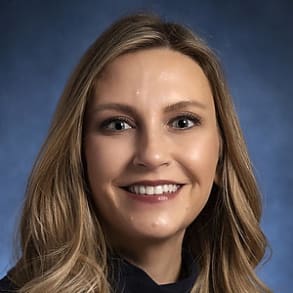Sara Kathryn Smith, medical director of pediatric liver transplantation at Johns Hopkins Children’s Center, discusses a unique case presented during the North American Society for Pediatric Gastroenterology, Hepatology and Nutrition’s 2023 annual meeting. In this presentation, Smith reviewed the treatment plan and possible future outcomes for a 14-month-old girl who was admitted to Johns Hopkins Children’s Center with jaundice, abdominal distension, malaise, intermittent fevers and emesis.
Hi, my name is Catherine Smith. I am the medical director of pediatric liver transplant here at Johns Hopkins. I'm here today to talk to you about a case that my team and I presented at the NAS began 2023 national meeting in San Diego California. This case involves a little girl who was 14 months old that presented with jaundice, abdominal distention, malaise intermittent fevers and emesis. She was found to have labs significant for elevated liver enzymes with her A LT greater than 4000 and her a ST greater than 7000. Her inr glucose and albumin were all normal indicative of normal synthetic function. She was admitted to our service and we worked her up with a working diagnosis of a viral infection with acute hepatitis. We did obtain a liver biopsy and at that time, the liver biopsy was significant for acute hepatitis without any clear findings of any other diseases. In the meantime, her laboratory work came back with a positive A N A which is a non-specific marker and a positive liver, kidney microsomal antibody. This antibody is seen in type two autoimmune hepatitis, which is an autoimmune hepatitis, that is more commonly seen in kids and is known to be more severe and harder to treat. At this time, we decided to go ahead and treat her with IV steroids for induction treatment of presumed autoimmune hepatitis type two. Her numbers did respond and improved but they did not normalize. So the decision was made to add on cellcept as a steroid sparing agent and eventually we added on tacrolimus as well. In the meantime, she was evaluated by the genetics team who set whole exome sequencing. This sequencing returned with a variant in the stat one gain of function. A de novo mutation, stat one is part of the jack pathway, which is the immunomodulating pathway that involves many different organs. With this mutation. We found out that she was at risk for immuno deficiencies in many different organ systems. At the time that we diagnosed her, the only organ that was affected was her liver and we did do some investigation for other organs, but we have not found any other organs involved. At this time, the decision was made to put her on a more targeted therapy. Since we now knew she had a stat one game of function. We sent authorization for AJ one inhibitor for her to start which she did start and she continues now on J one inhibitor. In addition to cup and steroids, her liver numbers continue to improve and she is now living a happy healthy life. Eventually she may need a stem cell transplant. But in the meantime, we are hopeful that we can keep her disease under control with the current medication regimen. This case is unique and represents new and exciting opportunities to discover if there are immuno deficiencies underlying autoimmune hepatitis type two and very young Children. I would like to thank the Nas began foundation for allowing us to present this work at the annual meeting. In addition, I would like to thank all the team members who are instrumental in getting this child diagnosed so that we can find a treatment so that she could have a normal childhood.



